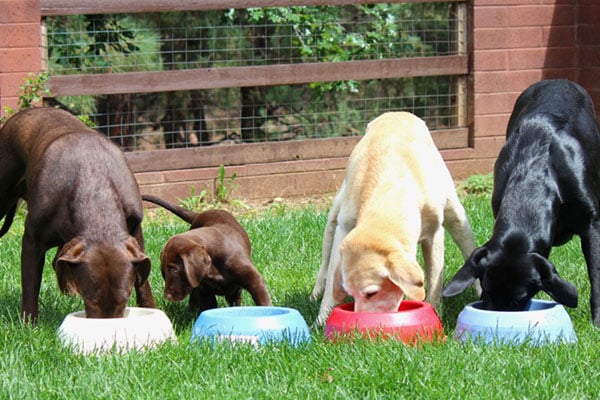
Last Updated on
By Tony Martins
It’s been a beautiful spring day, warm and sunny. Home early from work, you decide to spend a little quality time with your five month old puppy. Looking out the window into the backyard, you immediately notice the garden hose scattered about, in several now separate pieces. Stepping out on the porch it’s apparent that the wooden railing has been chewed and so has the door mat, there’s new excavation in the flowerbed, and strips of bark have been peeled off the shade tree. Your pup bursts out of the garage carrying a quart of motor oil that he apparently snatched off your workbench. It’s dripping from a dozen needle-like punctures, and you scream “noooo!” as the well-oiled youngster jumps up to greet you, planting his petroliferous paws on your best business suit. That’s it! You decide it’s time to (a) get rid of the pup, (b) open your five month old dog training book for the first time, or (c) tap out and call for help from a professional dog trainer.
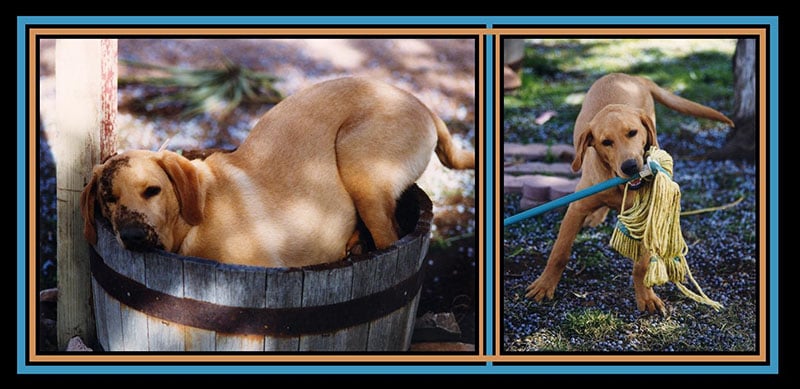
In more than thirty years of breeding, raising, and training dogs, I’ve received dozens of calls from folks having problems while attempting to train their own dogs. Ninety percent of the questions concern how to correct problems that more often than not were unknowingly caused by the novice trainer/owner of the dog asking the questions. Now you might be thinking that dog training must be difficult, but it’s actually quite simple. Anyone can do it – all you need is time, patience and a basic understanding of how to communicate with your canine student. Communication is the key to training dogs (and most animals for that matter). To be successful you first need to learn how to convey to the dog what you want him to do – and what you want him to not do – and this must be accomplished without confusing him. Dogs never really understand our words, but your dog will learn to interpret your language, as well as your tone and your actions. By making these sounds and sights simple and consistent, you will increase the likelihood that the dog’s interpretation and response will be in line with your expectations.
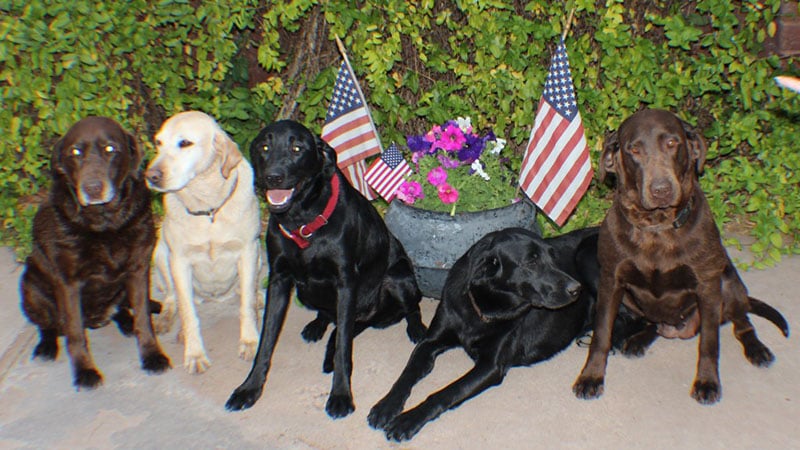
Contrary to popular belief, dogs are not especially intelligent regardless of the breed, and they have only a small measure of innate reasoning ability. They are however, highly trainable and learn through repetition. This is where time and patience pay dividends. Lessons must be repeated over and over for learning to occur, particularly when working with a very young dog. Repetition builds confidence in the youngster, and this is critically important. Unfortunately, many people today do not have the time or the patience required to successfully train a dog themselves without using force. Force training can save time, but this method should never be used with young dogs and frankly, it’s best to leave this method to the professional trainer. Besides, it’s more rewarding when the dog performs out of desire to please the trainer/owner (which could be you!) than out of fear.
It’s also important to understand that dogs should never be asked to do anything, because asking invites refusal and disobedience. Instead, you need to command the dog to do what you want done. The dog needs to understand that you are the master, and leader of the pack. This is particularly important with breeds like terriers that are known to be strong-willed. You must be able to convey your authority through your posture and the tone in your voice. If you cannot command with authority in your voice, you will no doubt have trouble convincing the dog that you are the boss. Commands should be simple, one or two words, and always delivered with the same tone every time. You can actually scold a dog while telling him that you love him, if you use a harsh tone and threatening posture. “Hey Bucko! Get your lazy butt off the couch and come over here and park your hairy behind on that doggy bed we paid 50-bucks for, and stay there!” This may be your normal speech pattern, but you will be much more successful in your training endeavor if you try a different approach. For example; stand by the doggy bed and while bending slightly forward clap your hands and command “Bucko! Come.” After the dog obeys, a simple command of “sit” followed by “stay” while thrusting the open palm of your hand toward the dog like a traffic cop, will complete the task of repositioning Bucko from the couch to the doggy bed.
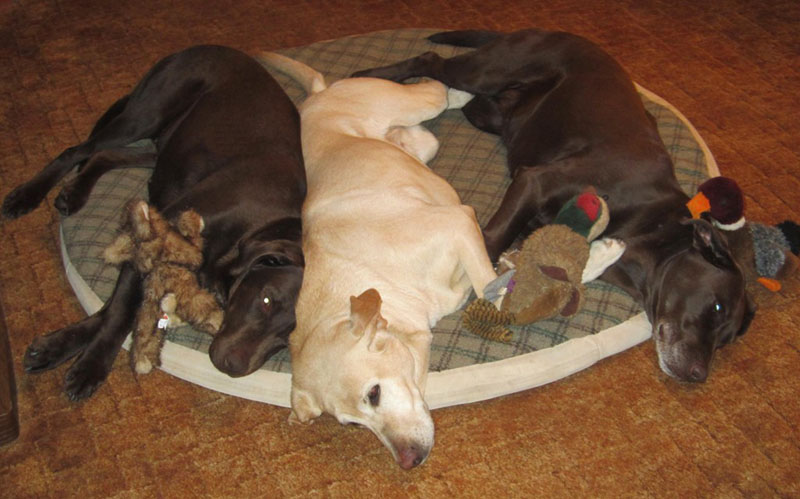
Here’s another important training tip: Never give a command that you are not in position to enforce. Believe it or not, disobedience is often the result of the trainer actually teaching the dog that it does not have to obey. So how can this happen? Here’s an excellent and humorous example I learned from legendary hunting dog trainer and author Richard Wolters (1920 – 1993) more than 30 years ago. Let’s say that your dog likes to bark, and although you have been working on the command “quiet” it is not yet cemented in Bucko’s brain. Now it’s 3:00 AM and Bucko is barking. You lay in bed still half-asleep for a few minutes hoping he will stop. He doesn’t. You jump out of bed and shout “quiet!” out the window. About the time you get settled under the covers, he starts barking again, and the sequence is repeated a few more times. Now wide awake, you scream out the window, “Bucko! If you don’t stop that blankety-blank barking right now I’m gonna come out there and tape your big mouth shut!” You have just unknowingly taught two very different lessons – Bucko has learned that it’s OK to ignore your command, and your neighbors have learned that you are the one with the big mouth!
Wolters example illustrates the basic training fundamentals of time and patience, and what should have been done in this example requires both. The “trainer” should have jumped out of bed and gone outside to the site of the infraction, immediately. While squeezing Bucko’s muzzle, the command “quiet” should have been given with authority. Next, time should have been taken to identify the stimulus for the dog’s vocal activity (possibly a neighbor’s cat taunting him from the top of the fence), and it should have been eliminated, if possible. And finally, to implant the lesson in Bucko’s brain, patience to repeat this entire process if (when) it became necessary would need to be exercised.
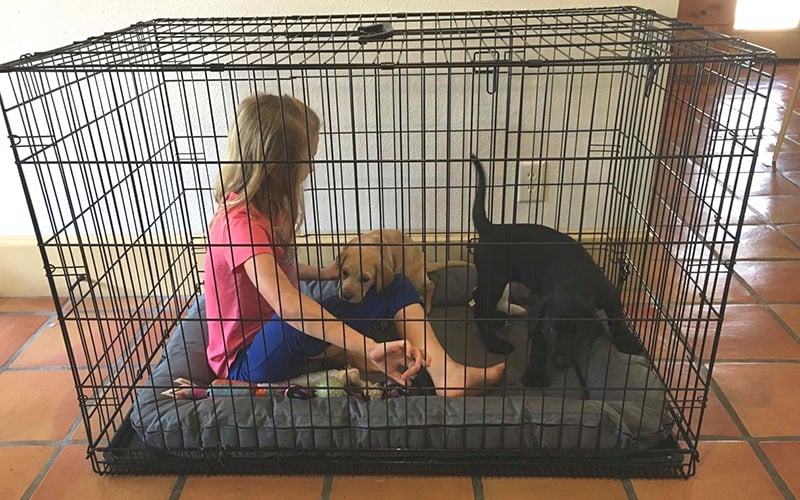
The old adage that “an ounce of prevention is worth a pound of cure” most certainly holds true when it comes to raising and training man’s best friend. It’s actually much easier to anticipate and prevent undesirable behavior in the puppy than it is to correct an established behavioral problem when the dog is older. Thus, it’s wise to start the training process with any new dog as soon as possible. Some experts believe that the canine brain is sufficiently developed at the age of seven weeks for training to begin. Wolters in fact, made a career out of this theory, and I have used his techniques a number of times with great success. Prior to seven weeks of age, the pup’s learning has been primarily “self-directed.” This means that his learning has served to fulfill basic needs – things like which of his mother’s nipples yield the most milk, and which corner of the litter box is the warmest. When the puppy comes home with you, his self-directed learning will continue. He will quickly learn where to get a drink of water, which cabinet in the pantry contains the bag of puppy chow, and where he’s most comfortable when checking out for nap time. Somewhere between the seventh and tenth week of his life, the pup will be able to recognize and accept “trainer-directed” learning. This means that he’s now capable of learning what you (the trainer) want him to learn.

At this age, you should start with the basic obedience commands – SIT, STAY, COME, HEEL and of course, NO – so your pet will learn manners and become a good citizen. Be careful with this last one, especially with the young dog. It’s easy to overuse NO, which will cause it to lose meaning and thus be ignored. I prefer to use the command QUIT to stop undesirable behavior. Use of either of these commands will diminish in direct proportion to your ability and success as a trainer. I also like to teach the command DOWN, which is particularly useful with the larger breeds. You might think it’s cute when your excited puppy jumps up to greet you, but this is an undesirable behavior that can be downright dangerous six months later when the puppy has grown into a 70-pound projectile. Remember that the attention span of a puppy is quite short, so early training should be limited to a few minutes for each session. Use your imagination to make the training fun. Start out with a short play session, and then proceed with the lesson when the pup settles down, so you can gain his full attention. Again, be patient, and as soon as the puppy loses interest, end the lesson and try again later. It’s important that you do not attempt training if the puppy is not paying attention, as this will only teach the pup that he can get away with ignoring you and your commands.
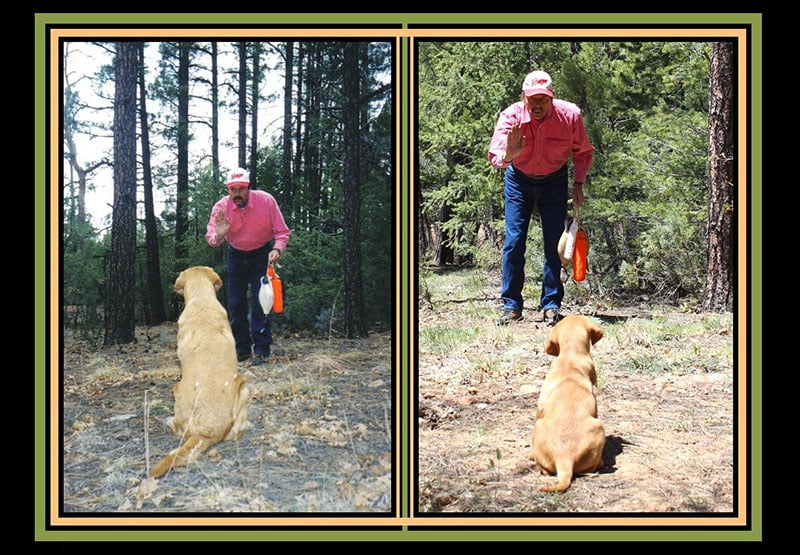
You should do your best to anticipate behavioral responses, to insure a successful outcome that will build confidence in the young dog. For example; when teaching STAY, the tendency will be for the pup to break and come to you. The pup will usually show signs that he is ready to break – like leaning forward, lifting a foot, shaking, etc. If you anticipate this and command COME just before he breaks, he has now done two things right instead of one thing wrong. As training progresses the pup will challenge you… this is guaranteed! Often, this will come as a refusal to obey. A pup that likes to play chase for example may refuse to come when commanded, and may dart off if you move toward him. Don’t chase him! If you do he’s won this battle, and learned that disobedience can be fun. Instead, turn and run away from the pup. He almost certainly will come running after you. As he approaches within reach, gather him up while commanding COME. Now he’s had his fun, but the command and proper behavior have been reinforced in his sponge-like brain as well.
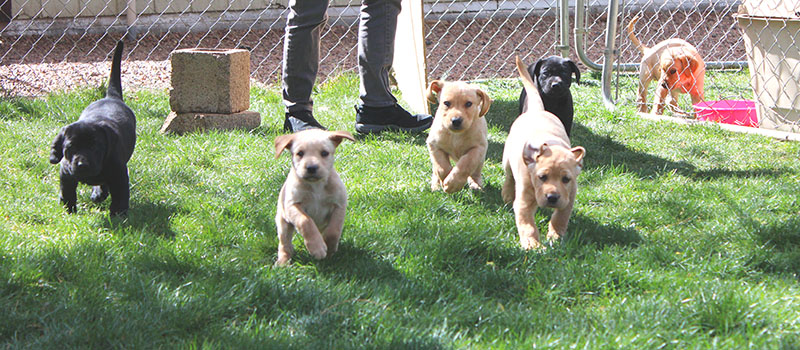
Research with service dogs has shown that training is most successful if it is continuous and without long periods of interruption once it begins. This point reaffirms the importance of repetition and regular interaction with human members of the pack. All too often the new puppy is brought home and receives lots of attention for the first few weeks. When the new wears off the pup is typically relegated to the backyard and left to his own devices (self-directed learning) for weeks on end. The bored pup will find things to amuse himself that the owner will undoubtedly find much less amusing. When the majority of the now unruly pup’s human contact consists of unpleasant scolding and reprimand, the chances of a successful outcome have been greatly diminished. Don’t let this happen to you and your puppy. It’s been proven that if a dog “learns to learn” it will continue to learn and enjoy the learning process throughout its life. A dog that has not been taught to learn will have difficulty learning as an older dog. This underscores the importance of trainer-directed learning in the development of your canine companion.
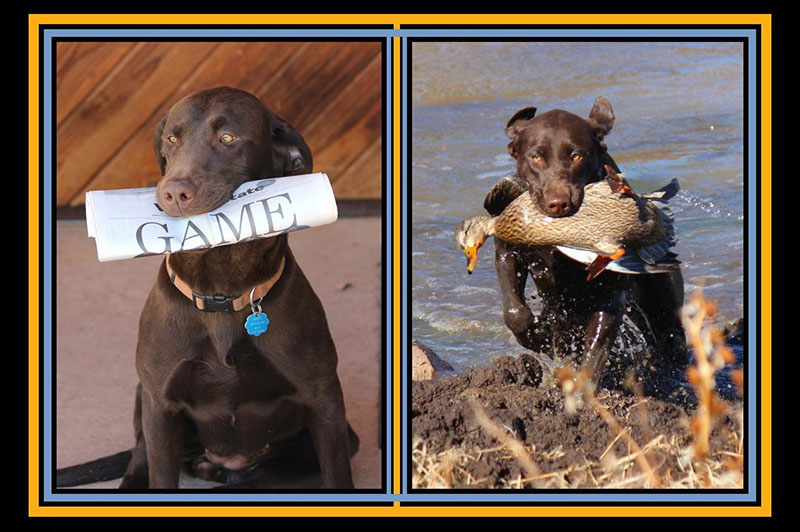
Before closing, a few words are in order about selecting a dog. First, you should choose an appropriate breed. If you live in a small apartment, it makes sense to avoid high-energy breeds like the Border Collie and Irish Setter, and very large breeds like the Saint Bernard and Irish Wolf Hound. Temperament is also a significant consideration, especially if you have young children. If you are looking for a multi-purpose dog that can perform useful work – like hunting birds afield or fetching the newspaper from the driveway – and double up as a companion and family member, the Golden and Labrador Retriever breeds rank at the top of my list.
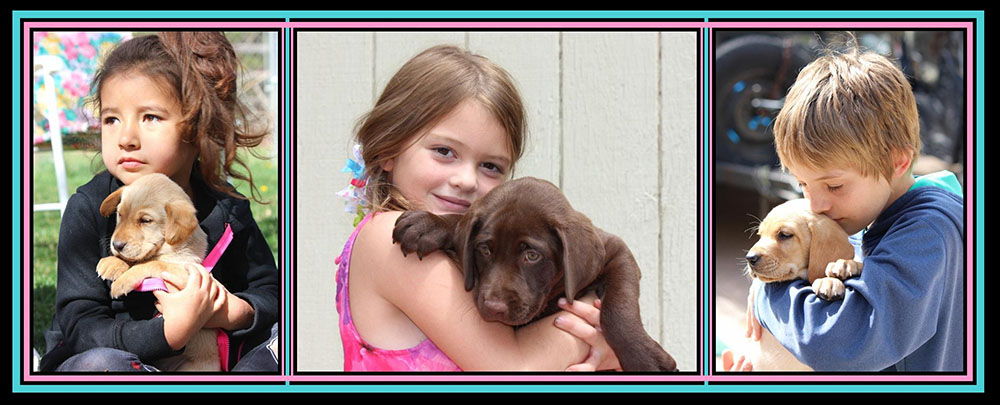
When purchasing a puppy, it’s wise to start with the best stock you can find, and to deal with a reputable breeder. Don’t make the mistake of assuming that because a breeder is well known that they will also be reputable. Ask for references, and check them. Make sure the breeder is producing dogs that have the characteristics you want, and that dealing with the breeder was a trouble-free positive experience. This does not mean that you need to shell out the cash to purchase a purebred dog, as mixed-breeds and dogs of unknown origin rescued from animal shelters can make wonderful pets and companions. The advantage with the purebred puppy is that you will know what you are getting if you do the proper research. Purebred or not, puppy or adult, the easiest dogs to train are those that will look you in the eye and readily give you their undivided attention.
It takes some time and effort to successfully train a dog, but the payoff is worthwhile – you can take a well-trained dog almost anywhere, and you will never have a better companion and friend.




Leave a Reply